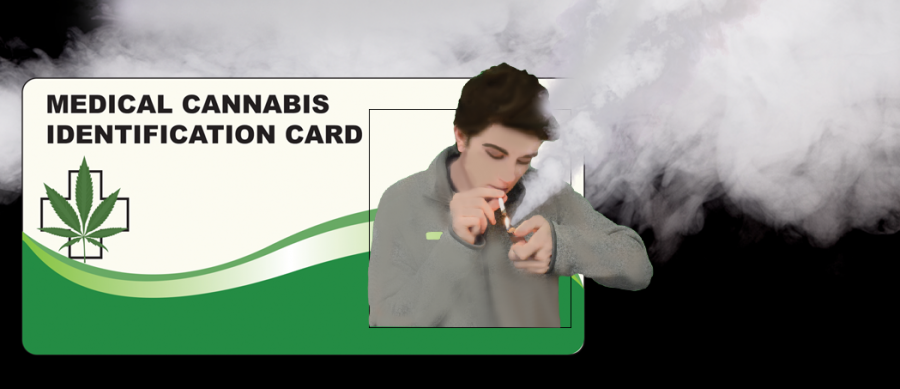Colorful sugar-dusted gummy edibles. A medical bottle packed with a few grams. Perfectly-rolled joints packaged in plastic tubes and a Bic lighter enameled with a gopher graphic.
These items lay askew on the console of Ali’s* ’16 car as she and her boyfriend stared at the assortment, their mouths agape. It was not the first time they’d bought pot, but it was the first time they had done so legally. According to a Chronicle poll of 372 students, 86 percent believe students who have medical marijuana cards use them for recreational purposes.
Hours earlier, Ali had walked past storefronts lining a Hollywood strip mall and entered one with a sign that read “Hollywood Easy Clinic” in glowing green lights. Not knowing what to expect, she said her palms were sweaty as she nervously approached the vaping receptionist, who was sitting behind a desk in what looked like a typical doctor’s waiting room.
Expecting to be given a hard time over her young age and assuming the doctor would consult her pediatrician about the validity of her claims, Ali was shocked to find that the process was as easy as advertised.
After filling out a medical form with basic contact information and the name of her general practitioner, someone took Ali’s blood pressure and led her to a back room where she consulted with a licensed medical marijuana card doctor.
“Have you tried weed before?,” “How does it affect you?” and “Why do you need the card?” were among the questions the doctor asked.
She had already planned her response to the last question.
“Anxiety is something that I deal with, and I do take medication for it,” Ali told him, noting that she was willing to try something new to help relieve her anxiety.
Less than 30 minutes later, the door with the painted green cross swung shut, and Ali walked away with a medical marijuana card. She could now legally enter a dispensary and purchase marijuana for herself.
Ali felt an air of uneasiness as she approached the dispensary due to its nondescript exterior and darkly tinted windows. After flashing her medical marijuana card to an employee, she was led back into a salesroom where she was filled with a sense of awe as she saw jars of weed lined up on the shelves and edibles displayed in a glass case.
“Buying marijuana products was as easy as buying candy at a candy shop,” Ali said.
Back in the car, Ali and her boyfriend couldn’t wait to pop open the shiny plastic prescription bottle, laden with medical labels, containing a joint. The two shared one in the parking lot.
Although she was immediately grateful for the medical marijuana prescription, Ali said it was not something she initially planned to do upon turning 18. Though her claim of anxiety is legitimate, and she believes marijuana helps alleviate it, she admits that, prior to her prescription, she primarily smoked weed for recreational purposes. Her friends convinced her to get the medical marijuana card solely for legal protection.
Medical marijuana first became legal in California in 1996 with the enactment of Proposition 215, which made it legal to possess and cultivate marijuana for the purpose of medical conditions such as anxiety, arthritis and glaucoma. California’s medical marijuana industry has since grown to include 1,250 shops, generating $1.3 billion in annual sales, according to the Los Angeles Times.
Although the 1996 proposition states that smoking marijuana should be used solely for medical purposes, students often abuse this. The driving force for many to obtain medical marijuana cards when they turn 18 is not legal protection but rather the ease with which they will be able to acquire weed, students say.
“Having a medical marijuana card eradicates the shady back door aspect of getting weed from a dealer,” Heather* ’17 said.
Heather plans to get a medical marijuana card when she turns 18 so that she can eliminate a middle-man dealer and instead purchase directly from a dispensary, which she anticipates will be more convenient. Heather will be able to select specific strains and quantities of marijuana and not have to worry about prices being arbitrarily raised, something she said she has experienced with dealers who she feels have tried to take advantage of her.
Chaplain Father J. Young believes that the combination of legal protection and hassle-free transactions enabled by Proposition 215 led to an up-tick in marijuana usage among Harvard-Westlake students. Although studies by Forbes suggest there was no correlation, Young believes otherwise and consequently wishes that Proposition 215 applied only to individuals over the age of 21 or required parental consent for individuals between 18 and 20 years old.
“I noticed a movement, not totally obviously at first, but a definite movement away from alcohol and towards marijuana [amongst Harvard-Westlake students],” Young said. “I felt like the numbers of kids that were drinking heavily may have actually gone down, and the numbers of kids who smoke heavily went up.”
Nic Smith ’17, who said he used to smoke frequently but has since become sober, agrees that medical marijuana cards lead to an increase in recreational smoking.
“Medical marijuana cards make cannabis a lot more accessible to a lot of people,” Smith said. “It is easy to slip into unhealthy habits and relationships.”
Students who currently possess a medical marijuana card said that their consumption of cannabis has increased since they received the prescription.
“The fact that there are so many dispensaries makes it so easy to smoke, and having the card makes me smoke more,” Steve* ’17 said.
The passage of California Proposition 64 in 2016 has led to speculation amongst health professionals over whether the legalization of recreational marijuana will increase smoking among high school students. The proposition, which goes into effect Jan. 1, 2018, will allow for adults 21 and older to possess, transport, purchase and use marijuana, according to The Cannabist.
Young said he expects the new law to have little impact on smoking among 18 to 20-year-olds.
“I would say a kid using a fake ID is going to put him or herself at an extra risk that he or she wouldn’t have to do if they had a medical marijuana card,” Young said.
Young’s position is supported by data from a 2015 Healthy Kids Colorado Survey, which discovered that the state’s legalization of marijuana in 2012 had no significant impact on teen smokers.
However, cannabis legalization in Colorado has led to the first reported overdose deaths from pot, according to CBS News.
“The high that comes from ingesting marijuana takes longer to kick in, so as you can imagine, it would be a little easier to overdose because you eat a cookie and don’t feel anything, and then you eat 20 more, and then – surprise – it kicks in, and you have overdosed,” Young said.
Regardless of the negative effects of marijuana legalization, Smith said he believes that cannabis is always going to be very prevalent among teenagers and adolescents, and medical cards increase its accessibility to students.
“I think that cannabis is always going to be prevalent among teenagers and adolescents because, although I wouldn’t say it is a healthy option, it is an easy solution to a lot of the stress that a lot of high schoolers and college students are under,” Smith said. “I wouldn’t say that medical cards are a bad thing, but I don’t know that it is necessarily helping with a lot of people’s productivity.”




























